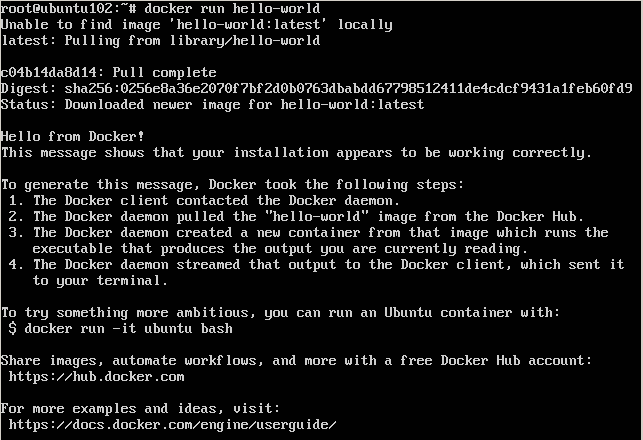所在的Team最近要面向微服务做一些创新,于是开始学习起Micro Service,在行业中,针对Micro Service有很多实现,我比较关注Docker,因为它覆盖的面比较广,各方面的需求它都会相应的解决方案,另外就是安装配置也比较简单。这篇文件摘自Docker官方站点,告诉大家怎么在Ubuntu上安装Docker(PS. 原本我是想在Windows上安装Docker的,可是Docker for Windows只supports win 10,无奈只能在win7 pro上通过virtual box+ubuntu trusty lts来实现安装docker,刚好之前做Hadoop分享的时候,已经安装了vitual box+ubuntu)。
原文 地址 https://docs.docker.com/engine/installation/linux/ubuntulinux/
Install Docker on Ubuntu
Docker is supported on these Ubuntu operating systems:
- Ubuntu Xenial 16.04 (LTS)
- Ubuntu Wily 15.10
- Ubuntu Trusty 14.04 (LTS)
- Ubuntu Precise 12.04 (LTS)
This page instructs you to install using Docker-managed release packages and installation mechanisms. Using these packages ensures you get the latest official release of Docker. If you are required to install using Ubuntu-managed packages, consult the Ubuntu documentation.
Note: Ubuntu Utopic 14.10 and 15.04 exist in Docker’s
APTrepository but are no longer officially supported.
Prerequisites
Docker requires a 64-bit installation regardless of your Ubuntu version. Additionally, your kernel must be 3.10 at minimum. The latest 3.10 minor version or a newer maintained version are also acceptable.
Kernels older than 3.10 lack some of the features required to run Docker containers. These older versions have known bugs which cause data loss and frequently panic under certain conditions.
To check your current kernel version, open a terminal and use uname -r to display your kernel version:
$ uname -r
3.11.0-15-generic
Note: If you previously installed Docker using
APT, make sure you update yourAPTsources to the new Docker repository.
Update your apt sources
Docker’s APT repository contains Docker 1.7.1 and higher. To set APT to use packages from the Docker repository:
- Log into your machine as a user with
sudoorrootprivileges. - Open a terminal window.
- Update package information, ensure that APT works with the
httpsmethod, and that CA certificates are installed.$ sudo apt-get update $ sudo apt-get install apt-transport-https ca-certificates - Add the new
GPGkey.$ sudo apt-key adv --keyserver hkp://p80.pool.sks-keyservers.net:80 --recv-keys 58118E89F3A912897C070ADBF76221572C52609D - Find the entry for your Ubuntu operating system.The entry determines where APT will search for packages. The possible entries are:
Ubuntu version Repository Precise 12.04 (LTS) deb https://apt.dockerproject.org/repo ubuntu-precise mainTrusty 14.04 (LTS) deb https://apt.dockerproject.org/repo ubuntu-trusty mainWily 15.10 deb https://apt.dockerproject.org/repo ubuntu-wily mainXenial 16.04 (LTS) deb https://apt.dockerproject.org/repo ubuntu-xenial mainNote: Docker does not provide packages for all architectures. Binary artifacts are built nightly, and you can download them from https://master.dockerproject.org. To install docker on a multi-architecture system, add an
[arch=...]clause to the entry. Refer to Debian Multiarch wiki for details. - Run the following command, substituting the entry for your operating system for the placeholder
<REPO>.$ echo "<REPO>" | sudo tee /etc/apt/sources.list.d/docker.list - Update the
APTpackage index.$ sudo apt-get update - Verify that
APTis pulling from the right repository.When you run the following command, an entry is returned for each version of Docker that is available for you to install. Each entry should have the URLhttps://apt.dockerproject.org/repo/. The version currently installed is marked with***.The output below is truncated.$ apt-cache policy docker-engine docker-engine: Installed: 1.12.2-0~trusty Candidate: 1.12.2-0~trusty Version table: *** 1.12.2-0~trusty 0 500 https://apt.dockerproject.org/repo/ ubuntu-trusty/main amd64 Packages 100 /var/lib/dpkg/status 1.12.1-0~trusty 0 500 https://apt.dockerproject.org/repo/ ubuntu-trusty/main amd64 Packages 1.12.0-0~trusty 0 500 https://apt.dockerproject.org/repo/ ubuntu-trusty/main amd64 Packages 1.11.2-0~trusty 0 500 https://apt.dockerproject.org/repo/ ubuntu-trusty/main amd64 Packages 1.11.1-0~trusty 0 500 https://apt.dockerproject.org/repo/ ubuntu-trusty/main amd64 PackagesFrom now on when you run
apt-get upgrade,APTpulls from the new repository.
Prerequisites by Ubuntu Version
- Ubuntu Xenial 16.04 (LTS)
- Ubuntu Wily 15.10
- Ubuntu Trusty 14.04 (LTS)
For Ubuntu Trusty, Wily, and Xenial, it’s recommended to install the linux-image-extra-* kernel packages. The linux-image-extra-* packages allows you use the aufs storage driver.
To install the linux-image-extra-* packages:
- Open a terminal on your Ubuntu host.
- Update your package manager.
$ sudo apt-get update - Install the recommended packages.
$ sudo apt-get install linux-image-extra-$(uname -r) linux-image-extra-virtual - Go ahead and install Docker.
Ubuntu Precise 12.04 (LTS)
For Ubuntu Precise, Docker requires the 3.13 kernel version. If your kernel version is older than 3.13, you must upgrade it. Refer to this table to see which packages are required for your environment:
| Package | Description |
|---|---|
| linux-image-generic-lts-trusty | Generic Linux kernel image. This kernel has AUFS built in. This is required to run Docker. |
| linux-headers-generic-lts-trusty | Allows packages such as ZFS and VirtualBox guest additions which depend on them. If you didn’t install the headers for your existing kernel, then you can skip these headers for the”trusty” kernel. If you’re unsure, you should include this package for safety. |
| xserver-xorg-lts-trusty | Optional in non-graphical environments without Unity/Xorg. Required when running Docker on machine with a graphical environment.
To learn more about the reasons for these packages, read the installation instructions for backported kernels, specifically the LTS Enablement Stack — refer to note 5 under each version. |
| libgl1-mesa-glx-lts-trusty |
To upgrade your kernel and install the additional packages, do the following:
- Open a terminal on your Ubuntu host.
- Update your package manager.
$ sudo apt-get update - Install both the required and optional packages.
$ sudo apt-get install linux-image-generic-lts-trustyDepending on your environment, you may install more as described in the preceding table.
- Reboot your host.
$ sudo reboot - After your system reboots, go ahead and install Docker.
Install
Make sure you have installed the prerequisites for your Ubuntu version.
Then, install Docker using the following:
- Log into your Ubuntu installation as a user with
sudoprivileges. - Update your
APTpackage index.$ sudo apt-get update - Install Docker.
$ sudo apt-get install docker-engine - Start the
dockerdaemon.$ sudo service docker start - Verify
dockeris installed correctly.$ sudo docker run hello-worldThis command downloads a test image and runs it in a container. When the container runs, it prints an informational message. Then, it exits.
Optional configurations
This section contains optional procedures for configuring your Ubuntu to work better with Docker.
- Create a docker group
- Adjust memory and swap accounting
- Enable UFW forwarding
- Configure a DNS server for use by Docker
- Configure Docker to start on boot
Create a Docker group
The docker daemon binds to a Unix socket instead of a TCP port. By default that Unix socket is owned by the user root and other users can access it with sudo. For this reason, docker daemon always runs as the root user.
To avoid having to use sudo when you use the docker command, create a Unix group called docker and add users to it. When the docker daemon starts, it makes the ownership of the Unix socket read/writable by the docker group.
Warning: The
dockergroup is equivalent to therootuser; For details on how this impacts security in your system, see Docker Daemon Attack Surface for details.
To create the docker group and add your user:
- Log into Ubuntu as a user with
sudoprivileges. - Create the
dockergroup.$ sudo groupadd docker - Add your user to
dockergroup.$ sudo usermod -aG docker $USER - Log out and log back in.This ensures your user is running with the correct permissions.
- Verify your work by running
dockerwithoutsudo.$ docker run hello-worldIf this fails with a message similar to this:
Cannot connect to the Docker daemon. Is 'docker daemon' running on this host?Check that the
DOCKER_HOSTenvironment variable is not set for your shell. If it is, unset it.
Adjust memory and swap accounting
When users run Docker, they may see these messages when working with an image:
WARNING: Your kernel does not support cgroup swap limit. WARNING: Your
kernel does not support swap limit capabilities. Limitation discarded.
To prevent these messages, enable memory and swap accounting on your system. Enabling memory and swap accounting does induce both a memory overhead and a performance degradation even when Docker is not in use. The memory overhead is about 1% of the total available memory. The performance degradation is roughly 10%.
To enable memory and swap on system using GNU GRUB (GNU GRand Unified Bootloader), do the following:
- Log into Ubuntu as a user with
sudoprivileges. - Edit the
/etc/default/grubfile. - Set the
GRUB_CMDLINE_LINUXvalue as follows:GRUB_CMDLINE_LINUX="cgroup_enable=memory swapaccount=1" - Save and close the file.
- Update GRUB.
$ sudo update-grub - Reboot your system.
Enable UFW forwarding
If you use UFW (Uncomplicated Firewall) on the same host as you run Docker, you’ll need to do additional configuration. Docker uses a bridge to manage container networking. By default, UFW drops all forwarding traffic. As a result, for Docker to run when UFW is enabled, you must set UFW’s forwarding policy appropriately.
Also, UFW’s default set of rules denies all incoming traffic. If you want to reach your containers from another host allow incoming connections on the Docker port. The Docker port defaults to 2376 if TLS is enabled or 2375 when it is not. If TLS is not enabled, communication is unencrypted. By default, Docker runs without TLS enabled.
To configure UFW and allow incoming connections on the Docker port:
- Log into Ubuntu as a user with
sudoprivileges. - Verify that UFW is installed and enabled.
$ sudo ufw status - Open the
/etc/default/ufwfile for editing.$ sudo nano /etc/default/ufw - Set the
DEFAULT_FORWARD_POLICYpolicy to:DEFAULT_FORWARD_POLICY="ACCEPT" - Save and close the file.
- Reload UFW to use the new setting.
$ sudo ufw reload - Allow incoming connections on the Docker port.
$ sudo ufw allow 2375/tcp
Configure a DNS server for use by Docker
Systems that run Ubuntu or an Ubuntu derivative on the desktop typically use 127.0.0.1 as the default nameserver in /etc/resolv.conf file. The NetworkManager also sets up dnsmasq to use the real DNS servers of the connection and sets up nameserver 127.0.0.1 in /etc/resolv.conf.
When starting containers on desktop machines with these configurations, Docker users see this warning:
WARNING: Local (127.0.0.1) DNS resolver found in resolv.conf and containers
can't use it. Using default external servers : [8.8.8.8 8.8.4.4]
The warning occurs because Docker containers can’t use the local DNS nameserver. Instead, Docker defaults to using an external nameserver.
To avoid this warning, you can specify a DNS server for use by Docker containers. Or, you can disable dnsmasq in NetworkManager. Though, disabling dnsmasq might make DNS resolution slower on some networks.
The instructions below describe how to configure the Docker daemon running on Ubuntu 14.10 or below. Ubuntu 15.04 and above use systemd as the boot and service manager. Refer to control and configure Docker with systemd to configure a daemon controlled by systemd.
To specify a DNS server for use by Docker:
- Log into Ubuntu as a user with
sudoprivileges. - Open the
/etc/default/dockerfile for editing.$ sudo nano /etc/default/docker - Add a setting for Docker.
DOCKER_OPTS="--dns 8.8.8.8"Replace
8.8.8.8with a local DNS server such as192.168.1.1. You can also specify multiple DNS servers. Separated them with spaces, for example:--dns 8.8.8.8 --dns 192.168.1.1Warning: If you’re doing this on a laptop which connects to various networks, make sure to choose a public DNS server.
- Save and close the file.
- Restart the Docker daemon.
$ sudo service docker restart
Or, as an alternative to the previous procedure, disable dnsmasq in NetworkManager (this might slow your network).
- Open the
/etc/NetworkManager/NetworkManager.conffile for editing.$ sudo nano /etc/NetworkManager/NetworkManager.conf - Comment out the
dns=dnsmasqline:dns=dnsmasq - Save and close the file.
- Restart both the NetworkManager and Docker.
$ sudo restart network-manager $ sudo restart docker
Configure Docker to start on boot
Ubuntu uses systemd as its boot and service manager 15.04 onwards and upstart for versions 14.10 and below.
For 15.04 and up, to configure the docker daemon to start on boot, run
$ sudo systemctl enable docker
For 14.10 and below the above installation method automatically configures upstart to start the docker daemon on boot
Upgrade Docker
To install the latest version of Docker with apt-get:
$ sudo apt-get upgrade docker-engine
Uninstallation
To uninstall the Docker package:
$ sudo apt-get purge docker-engine
To uninstall the Docker package and dependencies that are no longer needed:
$ sudo apt-get autoremove --purge docker-engine
The above commands will not remove images, containers, volumes, or user created configuration files on your host. If you wish to delete all images, containers, and volumes run the following command:
$ rm -rf /var/lib/docker
You must delete the user created configuration files manually.
很幸运,虽然在公司的重重防火墙之下,Docker的安装一路顺风,下面是运行docker run hello-world后的画面,通过画面我们可以知道4点:
- Docker client已经联系上docker daemon.
- Docker daemon从docker hub上下载了hello-world影像
- Docker daemon从hello-world影像创建了一个容器,运行了其中的可执行程序,并且输出了当前你看到的这些话
- Docker daemon 流式的将这些输出发送给Docker client,docker client再将它们发送给终端

